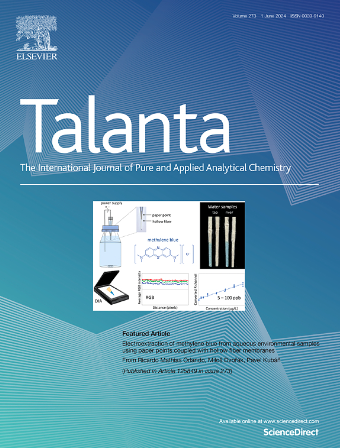皮秒激光诱导击穿光谱法对钢偏析的高通量微分析
IF 5.6
1区 化学
Q1 CHEMISTRY, ANALYTICAL
引用次数: 0
摘要
偏析监测在钢的质量控制中起着至关重要的作用,激光诱导击穿光谱(LIBS)可以作为诊断工具在这一过程中进行元素微量分析。在这项研究中,我们构建了一个使用1.2 kHz重复率皮秒激光(ps-laser)的超快LIBS系统,以实现空间分辨率为1 μm的高通量分析钢的偏析。在1 cm2的面积上,成功完成了1亿个像素的大规模元素成像,总时间仅为25.27 h,与电子探针微分析(EPMA)结果一致,从而证实了测量的可靠性。由于其相对性能,LIBS有潜力发展成为钢偏析分析的替代方法。本文章由计算机程序翻译,如有差异,请以英文原文为准。

High-throughput microanalysis of steel segregation using picosecond laser-induced breakdown spectroscopy
Segregation monitoring plays an essential role in the quality control of steels, and laser-induced breakdown spectroscopy (LIBS) can be employed as a diagnostic tool in this process for elemental microanalysis. In this study, we constructed an ultrafast LIBS system employing a 1.2 kHz repetition-rate picosecond laser (ps-laser) to achieve high-throughput analysis of steel segregation with a spatial resolution of 1 μm. A large-scale elemental imaging was successfully accomplished with 100 million pixels covering an area of 1 cm2, while only consuming a total time of 25.27 h. The mapping results demonstrated excellent agreement with those obtained from Electron Probe Microanalysis (EPMA), thereby confirming the measurement reliability. Due to its comparative performance, LIBS has the potential to be developed as an alternative method for steel segregation analysis.
求助全文
通过发布文献求助,成功后即可免费获取论文全文。
去求助
来源期刊

Talanta
化学-分析化学
CiteScore
12.30
自引率
4.90%
发文量
861
审稿时长
29 days
期刊介绍:
Talanta provides a forum for the publication of original research papers, short communications, and critical reviews in all branches of pure and applied analytical chemistry. Papers are evaluated based on established guidelines, including the fundamental nature of the study, scientific novelty, substantial improvement or advantage over existing technology or methods, and demonstrated analytical applicability. Original research papers on fundamental studies, and on novel sensor and instrumentation developments, are encouraged. Novel or improved applications in areas such as clinical and biological chemistry, environmental analysis, geochemistry, materials science and engineering, and analytical platforms for omics development are welcome.
Analytical performance of methods should be determined, including interference and matrix effects, and methods should be validated by comparison with a standard method, or analysis of a certified reference material. Simple spiking recoveries may not be sufficient. The developed method should especially comprise information on selectivity, sensitivity, detection limits, accuracy, and reliability. However, applying official validation or robustness studies to a routine method or technique does not necessarily constitute novelty. Proper statistical treatment of the data should be provided. Relevant literature should be cited, including related publications by the authors, and authors should discuss how their proposed methodology compares with previously reported methods.
 求助内容:
求助内容: 应助结果提醒方式:
应助结果提醒方式:


